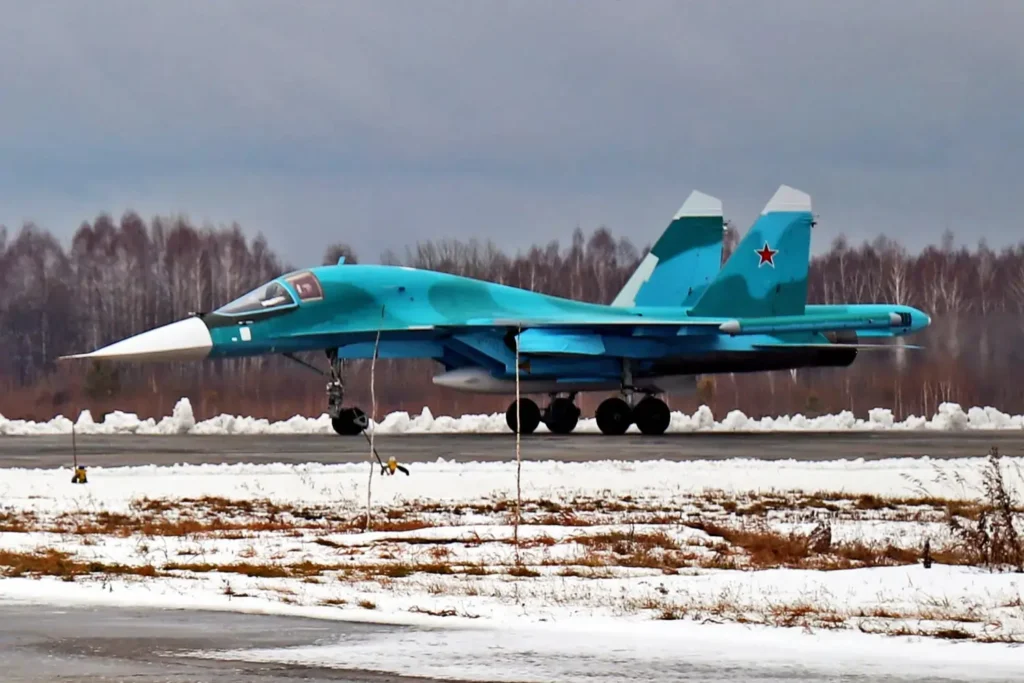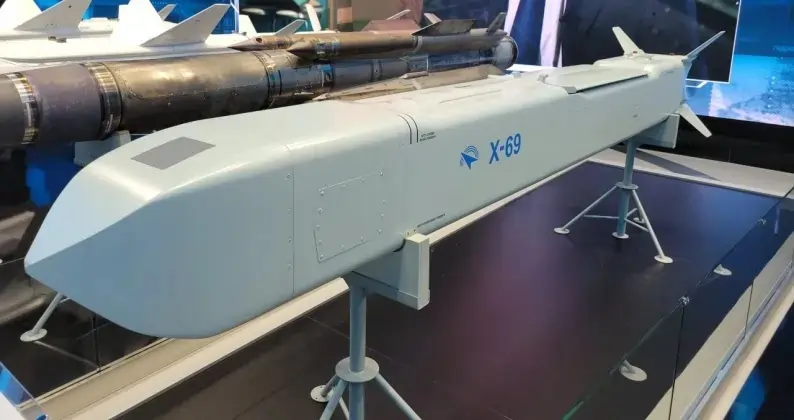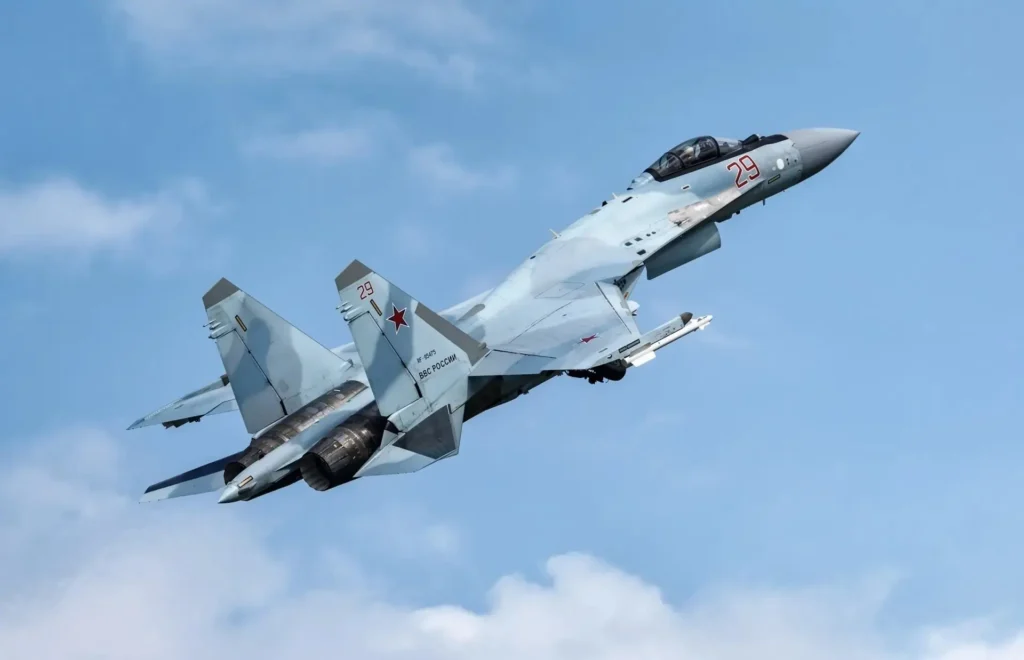Russia has recently introduced its new X-69 (Kh-69) long-range air-launched cruise missiles (ALCM), signifying a shift in its military strategy. The X-69, lighter and less observable compared to its predecessors, holds the capability to be launched from Russian Su-34 and Su-35 tactical aircraft, marking a departure from the exclusive use of strategic bombers. This article delves into the specifications, implications, and international prospects of this new development.

Table of Contents
Key Points
Introduction of Kh-69 Missile
- Russia has introduced the Kh-69 (X-69) long-range air-launched cruise missile (ALCM) as part of its efforts to enhance strike capabilities in Ukraine, overcoming the degraded air defense systems.
- Ukrainian media and the Ukrainian Air Force Spokesperson attributed the April 11 strike on the Trypilska Thermal Power Plant to the Kh-69 missile, launched from a distance of 400 km.
Features and Capabilities
- The Kh-69 missile weighs 770 kilograms, carries warheads of various types weighing 310 kg, and has a range initially stated at 290 km but demonstrated to reach distances of 400 km.
- Equipped with an inertial navigation system (INS) and GLONASS navigation satellites, the missile has a Circular Error Probability (CEP) of less than five meters, providing high accuracy.
- Its optical-electronic homing system, based on a reference map, allows the missile to change direction before launch, confusing medium and short-range air defense systems.
Deployment and Aircraft Compatibility
- Unlike the heavier Kh-101, the Kh-69 can be launched from more numerous Su-34 and Su-35 tactical aircraft, sparing the wear and tear of strategic bombers like the Tupolev Tu-160.
- The missile can also be launched from the Su-57 stealth fighter and has radar-absorbent material to maintain a stealth profile for some distance after launch.
International Prospects
- Russia may introduce newer variants of the Kh-69 missile or improve new production batches, with a concurrent commercial push at future defense exhibitions.
- The Kh-69 could be an option for the Indian Air Force’s Multi-Role Fighter Aircraft (MRFA) project, potentially fused with India’s Navigation with Indian Constellation (NaVIC) satellite navigation system.
Strategic Importance for India
- The Kh-69 offers itself as a lighter, domestically produced, and sophisticated ALCM with guidance, targeting, maneuvering, and air defense-evading capabilities, suitable for India’s strategic needs.
- Alongside the BrahMos, the Kh-69 can be a valuable addition to India’s air-launched cruise missile (ALCM) inventory, especially in potential conflicts with Pakistan or China, utilizing India’s satellite surveillance system for target identification.
The X-69: A Game Changer
The X-69 missile, with a flight weight of 770 kilograms and a range of 290 kilometers, aims to combine the destructive power and precision of the Kh-101 and Kh-555 into a smaller and less observable size. Recent reports have revealed that the missile can reach distances of up to 400 kilometers. Equipped with an inertial navigation system (INS) and an optical-electronic homing system, the X-69 boasts incredibly high accuracy, with a Circular Error Probability (CEP) of less than five meters.

Before launch, the missile can be programmed to change direction, confusing medium and short-range air defense systems. Its rectangular cross-section and radar-absorbent material contribute to its stealth capabilities, enabling it to be placed in the internal weapons bay of the Su-57 stealth fighter. Moreover, the design includes foldable wings, allowing the missile to maintain its stealth profile for some distance after launch. This development is a significant departure from the use of heavier and larger missiles like the Kh-101, previously fired from the Tupolev Tu-160 strategic bomber.
Production Challenges and International Prospects
While Russia’s arms factories may struggle to keep up with the demand for the X-69 missile, the June 2023 report by the Center for Strategic and International Studies (CSIS) outlines that it is unrealistic to expect Russia to ever run out of missiles. Despite sanctions and export controls, Russia has found ways to continue producing missiles. The unveiling of the missile at the Dubai Air Show in November 2023 indicates that Russia is prepared for international production and sales. Moreover, Russia has a history of agreeing to foreign production of its defense platforms, especially in developing countries with reliable industrial capacities.
Implications for Ukraine and Beyond
The use of the Kh-69 missile is part of Russia’s continued efforts to improve strike packages and penetrate Ukraine’s degraded air defense. The missile’s long-range capabilities and the ability to be launched from more numerous Su-34 and Su-35 tactical aircraft pose a significant threat to Ukraine. Ukrainian media attributed the April 11 strike on the Trypilska Thermal Power Plant (TPP) in Kyiv Oblast to the Kh-69. Additionally, the missile’s success has prompted other think tanks to consider the heavily sanctioned Russian defense industrial base. A counter-argument against concerns regarding production capability is the possibility of assembly or joint manufacturing of the missile with a Transfer of Technology (ToT) with the customer nation.
International Prospects: A Good Option for the Indian Air Force
India, particularly, may find the X-69 missile a favorable addition to its air-launched cruise missile (ALCM) inventory. The MiG-35 and Su-35S, contenders for the Indian Air Force’s (IAF) Multi-Role Fighter Aircraft (MRFA) project, could benefit from the addition of the X-69. Negotiations with Rosoboronexport to fuse the missile with India’s Navigation with Indian Constellation (NaVIC) satellite navigation (SatNaV) system could be a possibility. India’s Bharat Dynamics Limited (BDL) already manufactures a host of indigenous missiles, making the assimilation of the X-69 into their arsenal a feasible prospect.
Conclusion
The introduction of the X-69 missile marks a significant shift in Russia’s military strategy, posing a looming threat to Ukraine and potentially altering the landscape of international defense. As Russia further studies the missile’s success, newer variants or improvements may be introduced, accompanied by a concurrent commercial push at future defense exhibitions. The X-69’s lighter weight, sophisticated guidance, targeting, maneuvering, and air defense-evading capabilities make it a viable option for various air forces, including the Indian Air Force, potentially reshaping the dynamics of modern aerial warfare.
Read More Articles
- Why Cyber Security is Essential: Exploring 5 Key Reasons
- Astra Space’s Financial Struggles: A Close Brush with Bankruptcy
- Introducing the Xogdor Rocket to the Military Realm
- The Formation of the LEO Owner Operators Affinity Group
- Expanding Satellite-to-Smartphone Connectivity
- Navigating Privacy and Safety in Adult Webcam Streaming
- Choosing Between Open Source and Proprietary LLMs
- Rethinking Food Packaging for a Sustainable Future
- Mastering Typography in Web Design
- Exploring Typography Trends for Digital Design in 2024
- Unlocking Sustainable Economic Growth Through Innovation
- Navigating the Financial Landscape of Executive Education and MBA Programs
- Understanding Information Technology: The Backbone of Modern Business
- Understanding Algorithms: Definition, Functionality, and Real-Life Applications
- Understanding Machine Learning: A Comprehensive Exploration
- Unlocking the Power of Machine Vision: Revolutionizing Industries
- Unlocking the Power of Expert Systems: Enhancing Decision-Making with AI
- Unlocking the Power of Natural Language Processing
- Unlocking the Secrets of Artificial Intelligence
- Optimizing Logistics with AI: Revolutionizing Efficiency in Package Routing
Frequently Asks Questions
What is the Su-35 fighter jet, and what are its capabilities?
The Su-35 is a fourth-generation supersonic fighter jet developed by Russia’s Sukhoi Aviation Corporation. It is an advanced derivative of the Su-27 design and is equipped with highly advanced avionics, improved engines, and a significant weapons payload. Capable of engaging multiple airborne and surface targets simultaneously, the Su-35 boasts exceptional maneuverability and is considered one of the most formidable air superiority fighters in the world.
What are the primary features of the Su-35 fighter jet?
The primary features of the Su-35 fighter jet include:
- Advanced avionics and radar systems for increased situational awareness
- Exceptional maneuverability with thrust-vectoring engines
- Long-range air-to-air and air-to-ground attack capabilities
- High-speed performance and supersonic cruise
What armaments can the Su-35 carry?
The Su-35 can carry a wide range of armaments, including:
- Air-to-air missiles such as the R-77 and R-27
- Air-to-surface missiles such as the Kh-59 and Kh-31
- Precision-guided munitions
- Bombs and rockets
What is the X-69 (Kh-69) missile, and how is it deployed with the Su-35?
The X-69 (Kh-69) missile is a long-range air-launched cruise missile (ALCM) developed by Russia. It is deployed with the Su-35 and other tactical aircraft, offering a significant advantage in long-range strike capabilities. The Su-35 can carry and launch the X-69 missile, allowing it to engage targets from a considerable distance.
What is the operational range of the X-69 (Kh-69) missile?
Initially stated to have a range of 290 km, the X-69 (Kh-69) missile has demonstrated the ability to reach distances of up to 400 km. This extended range allows for more effective engagement of targets while reducing the risk to the launching aircraft.
How does the X-69 (Kh-69) missile achieve high accuracy?
The X-69 (Kh-69) missile achieves high accuracy through:
- Inertial navigation system (INS) with GLONASS navigation satellites during the cruising phase
- Optical-electronic homing system based on a reference map, enabling direction change before launch
- Circular Error Probability (CEP) of less than five meters, providing precise targeting
Can the X-69 (Kh-69) missile be launched from other aircraft besides the Su-35?
Yes, the X-69 (Kh-69) missile can also be launched from other aircraft such as the Su-34 and Su-57, providing multiple platforms for its deployment. This versatility allows for flexible and efficient strike capabilities.
What are the international prospects for the X-69 (Kh-69) missile?
Russia is likely to further study the missile’s success and possibly introduce newer variants or improvements in new production batches, with a concurrent commercial push at future defense exhibitions. Countries already using the Su-30 or the Su-35S could potentially fuse the X-69 (Kh-69) missile into their arsenal.
How does the X-69 (Kh-69) missile contribute to India’s defense strategy?
The X-69 (Kh-69) missile can be a valuable addition to India’s air-launched cruise missile (ALCM) inventory. It offers itself as a lighter, domestically produced, and sophisticated ALCM with guidance, targeting, maneuvering, and air defense-evading capabilities. Fused with India’s Navigation with Indian Constellation (NaVIC) satellite navigation system, it becomes even more effective in India’s strategic context.
Why is the Su-35 considered a significant asset for modern air forces?
The Su-35 is considered a significant asset for modern air forces due to its:
- Superior maneuverability and combat performance
- Advanced avionics and radar systems
- Versatility in carrying a wide range of armaments
- Long-range engagement capabilities
- Ability to engage multiple airborne and surface targets simultaneously


